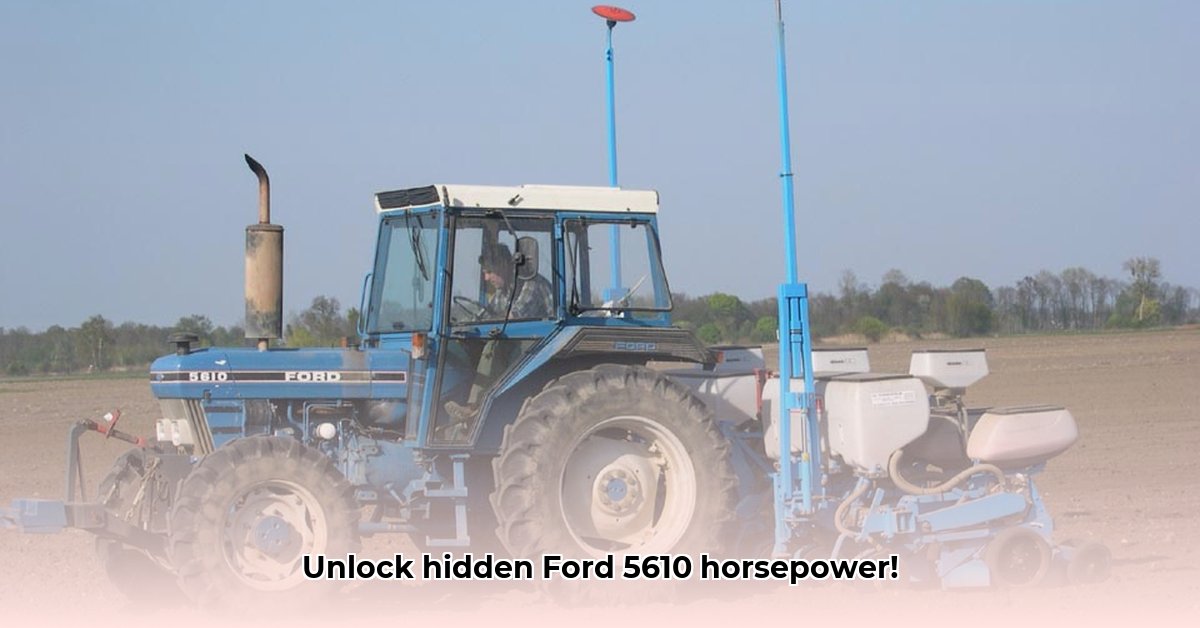
5610 Ford Tractor HP: Unlocking the Power of a Farming Legend
The Ford 5610 tractor, a stalwart of the fields from 1982 to 1993, remains a testament to robust agricultural engineering. Understanding its horsepower (hp) output, however, requires a nuanced approach. While readily available information often cites varying figures, a deeper look reveals the reasons behind these discrepancies and provides a clearer picture of this workhorse's capabilities. Why the range in reported horsepower? Let's explore. For detailed diagrams, check out the Ford 5610 parts diagrams.
The Horsepower Riddle: Why the Numbers Vary
Reports of the Ford 5610's horsepower range from approximately 62 PTO horsepower (power delivered to implements) to 72 gross engine horsepower (maximum engine output). This variation stems from several factors. First, the lack of standardized testing methods during its production years led to inconsistencies. Second, the engine's condition—wear and tear—significantly impacts its power output. A well-maintained tractor will naturally generate more horsepower than a neglected one. Finally, the specific model and configuration might subtly affect the power output. Therefore, relying solely on a single source for horsepower figures is misleading. A comprehensive understanding necessitates considering multiple sources and acknowledging this inherent variability. What is the average horsepower, considering these factors? That's our next topic.
The Engine and Transmission: A Powerful Partnership
The Ford 5610's performance hinges on its 4.2-liter four-cylinder diesel engine, designed to handle demanding agricultural tasks. This powerful engine, however, works in tandem with the transmission—the gearbox regulating power delivery to the wheels. Various transmission options were available, including an 8-speed synchromesh and a more advanced 16-speed partial power shift system. The choice of transmission directly influenced the tractor's operational characteristics, allowing farmers to tailor their machine to specific needs and job requirements. The interaction between engine and transmission is crucial; understanding this relationship helps in appreciating the tractor's overall capability. What were the typical transmission ratios available?
Beyond the Numbers: Features That Made it Great
Beyond the horsepower figures, several features contributed to the Ford 5610’s success. Power steering reduced operator fatigue during extended use, while differential locks enhanced traction in challenging conditions. Further enhancing operator comfort and safety were optional features like a Roll Over Protective Structure (ROPS) and an air-conditioned cab, especially valuable in hot climates. These features collectively elevated the operator experience, contributing to the machine’s enduring appeal. How did these design choices impact the Ford 5610's overall market position?
From Series I to Series II: Evolution of a Workhorse
The Ford 5610 underwent refinements throughout its production run. Later Series II models incorporated subtle improvements without drastically altering horsepower. These enhancements focused on improving hydraulic system efficiency and overall user-friendliness. The introduction of a more affordable 5610S model further broadened its appeal to a wider range of farmers. These iterative changes demonstrate Ford's commitment to continuous improvement, solidifying the tractor's position in the market. What specific modifications were made to the hydraulic system over the years?
Keeping Your Ford 5610 Running Strong: A Guide to Longevity
Numerous Ford 5610 tractors remain operational, highlighting their robust design and build quality. However, consistent performance requires diligent maintenance. Regular oil changes, filter replacements, and thorough inspections of critical engine components are crucial for optimal performance and extended lifespan. Proactive maintenance is an investment, ensuring years of reliable service from this classic tractor. What is the recommended oil change interval for optimal performance?
Ford 5610 Tractor Specifications at a Glance
| Feature | Specification | Notes |
|---|---|---|
| Ford 5610 Tractor HP | Approximately 68.5 to 78.5 hp (variant dependent) | This is an approximation; exact horsepower varied by model and testing. |
| Engine | 4.2L Four-Cylinder Diesel | A durable and reliable engine for its time. |
| Transmission | 8-speed or 16-speed | Selection depended on the specific model and year. |
| Hydraulic System | Open-center system; flow rates varied | Lower flow rates compared to more modern tractors. |
| PTO | 540/1000 rpm option | Offered versatility for a wide range of implements. |
The Ford 5610's legacy is built on its robust engine, versatile transmission options, and practical features. While the precise horsepower can vary, its enduring reliability and performance remain key to its continued relevance in agricultural history.
How to Troubleshoot Ford 5610 Tractor Hydraulic System Issues
Key Takeaways:
- Hydraulic failure often points to a faulty pressure relief valve (PRV).
- External contamination is a frequent cause.
- Regular maintenance prevents major problems.
- Understanding your tractor's hydraulic system type (open-center) is crucial.
- A systematic approach is more effective than guesswork.
Understanding Your Ford 5610's Hydraulics
The Ford 5610's hydraulic system, vital for powering implements, relies on consistent pressure. Problems often stem from contamination (dirt, debris, incompatible fluids). External sources, such as connecting to contaminated equipment, frequently introduce contaminants. Recognizing these potential sources is the first step in effective troubleshooting.
Step-by-Step Troubleshooting
Visual Inspection: Begin with a thorough visual inspection for leaks, damaged hoses, or loose connections.
Check Hydraulic Fluid: Assess the fluid level and condition. Dirty fluid indicates contamination, requiring immediate attention.
Pressure Relief Valve (PRV): Examine the PRV for proper function. A malfunctioning PRV can cause complete hydraulic failure.
Investigate the Hydraulic Pump: An auxiliary hydraulic pump (where applicable) might be the source of the problem.
System Flushing: If contamination is suspected, a complete system flush is necessary.
Preventative Maintenance is Key
Regular fluid changes, filter replacements, and visual inspections are essential for preventing costly hydraulic repairs. Proactive maintenance is a cost-effective strategy for ensuring the long-term reliability of your Ford 5610.